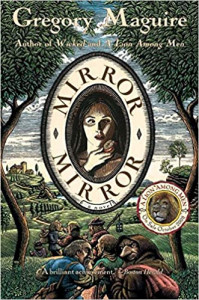 Liz Milner contributed this review.
Liz Milner contributed this review.
Gregory Maguire specializes in recasting fairy tales to fit modern preoccupations and sensibilities. It takes a certain amount of chutzpah to take stories that everyone knows too well and recycle them. Maguire has done this trick many times: his published works for adults include Confessions of an Ugly Stepsister, a remake of the “Cinderella” story told from the stepsister’s point of view; Wicked: The Life and Times of the Wicked Witch of the West, The Wizard of Oz told from the Wicked Witch’s point of view, and Lost, which is not strictly a retelling but draws heavily on Charles Dickens’ A Christmas Carol.
In Mirror, Mirror Snow White and the Seven Dwarfs meet Lucrezia Borgia in an inspired blend of folktales and historical gossip. Poison is the link between the two tales, as poisoner extraordinaire Lucrezia Borgia takes the place of Snow White’s evil stepmother.
The heroine, Bianca de Nevada, whose name literally means “white covered with snow,” lives with her devoted but wimpy father Vicente, a Borgia family retainer, at Montefiore, a mountain castle strategically located on the border of Tuscany. Their happy life ends when Cesare Borgia sends Vicente off on a quest to steal a bough from the original tree of knowledge. Cesare figures that this will give him a strategic advantage over neighboring princes. Bianca is left in the care of Lucrezia. The action is punctuated by an ironic dialog between the pious but opportunistic priest, Fra Ludovico, and the cynical old housekeeper, Primavera.
The story is told from several points of view: that of Bianca, various dwarfs, Lucrezia Borgia, the narrator and a mysterious onlooker. Add poetic language, meticulous scene painting, a unicorn, a magic mirror, a trip to the underworld, and a simple-minded goose boy who is also the son of the Pope, and you have the makings of an imaginative tour de force.
Unfortunately, the story bogs down in the final third of the novel. Both plot and characterization seem to have been edged out by artifice. Because the tale is told from so many points of view, there is no real protagonist. What remains of the story is essentially a beautiful edifice with few signs of life: Bianca/Snow White is in a catatonic state through most of the final chapters. Lucrezia Borgia realizes that evil deeds aren’t fun when you don’t have someone special to share them with and goes into a prolonged, ultimately fatal, pout. Wimpy Vicente, shrewish Primavera and calculating Fra Ludovico fade away, and the dwarfs, who throughout the book have been slowly and fascinatingly metamorphosing from stones to humans, become stalled in a state that is neither fully animate nor inanimate. When Bianca/Snow White is finally wakened from her death-in-life, it is not by a handsome prince, but by a character who appeared briefly in the early part of the book and stayed away so long that I had to cudgel my brains to remember who he was. There is simply no energy left to carry the story along, and, like Bianca’s feckless dad, it finally wimps out altogether.
The book itself is unusually handsome and hearkens back to an era when even adult books were elaborately illustrated. The dust jacket features a very clever panoramic color “woodcut” of the Italian countryside with the seven dwarfs in the foreground. In the center of the jacket is a cutaway, which reveals a portion of the hardcover illustration. Each of the novel’s four books has a full-page illustration, and each chapter begins with a tiny cameo-shaped illustration at the head of the text.
(Regan Books, 2003)
